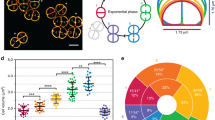Abstract
NUCLEAR division and the associated division of the cell and cell organelles have been examined in thirty-two species of the Euglenineae, drawn from thirteen genera. The main findings on the structure and mechanics of mitosis in this group are as follows.
This is a preview of subscription content, access via your institution
Access options
Subscribe to this journal
Receive 51 print issues and online access
$199.00 per year
only $3.90 per issue
Buy this article
- Purchase on Springer Link
- Instant access to full article PDF
Prices may be subject to local taxes which are calculated during checkout
Similar content being viewed by others
References
Pringsheim, E. G., Nova Acta Leopoldina (18), 125, 1 (1956).
Baker, W. B., Biol. Bull., 51, 321 (1926).
Hartmann, M., and Chagas, C., Mem. Inst. Osw. Cruz, 2, 64 (1910).
Brown, V. E., Quart. J. Micro. Sci., N.S., 73, 405 (1930).
Author information
Authors and Affiliations
Rights and permissions
About this article
Cite this article
LEEDALE, G. Mitosis and Chromosome Numbers in the Euglenineae (Flagellata). Nature 181, 502–503 (1958). https://doi.org/10.1038/181502b0
Issue Date:
DOI: https://doi.org/10.1038/181502b0
This article is cited by
-
Morphogenesis of the feeding apparatus ofEntosiphon sulcatum
Protoplasma (1992)
-
Théorie de la cible: Un modèle markovien pour l'évolution génétique d'une mutation latente
Acta Biotheoretica (1973)
-
Einflu� von R�ntgenstrahlen und Hemmstoffen der Proteinsynthese auf die Synthese von Chlorophyll und NADP-abh�ngiger Glycerinaldehyd-3-Phosphat-Dehydrogenase in ergr�nender Euglena gracilis
Archiv f�r Mikrobiologie (1973)
-
Structure and physiology of Euglena spirogyra. I and II
Archiv f�r Mikrobiologie (1965)
-
The evidence for a meiotic process in the euglenineae
Archiv f�r Mikrobiologie (1962)
Comments
By submitting a comment you agree to abide by our Terms and Community Guidelines. If you find something abusive or that does not comply with our terms or guidelines please flag it as inappropriate.



